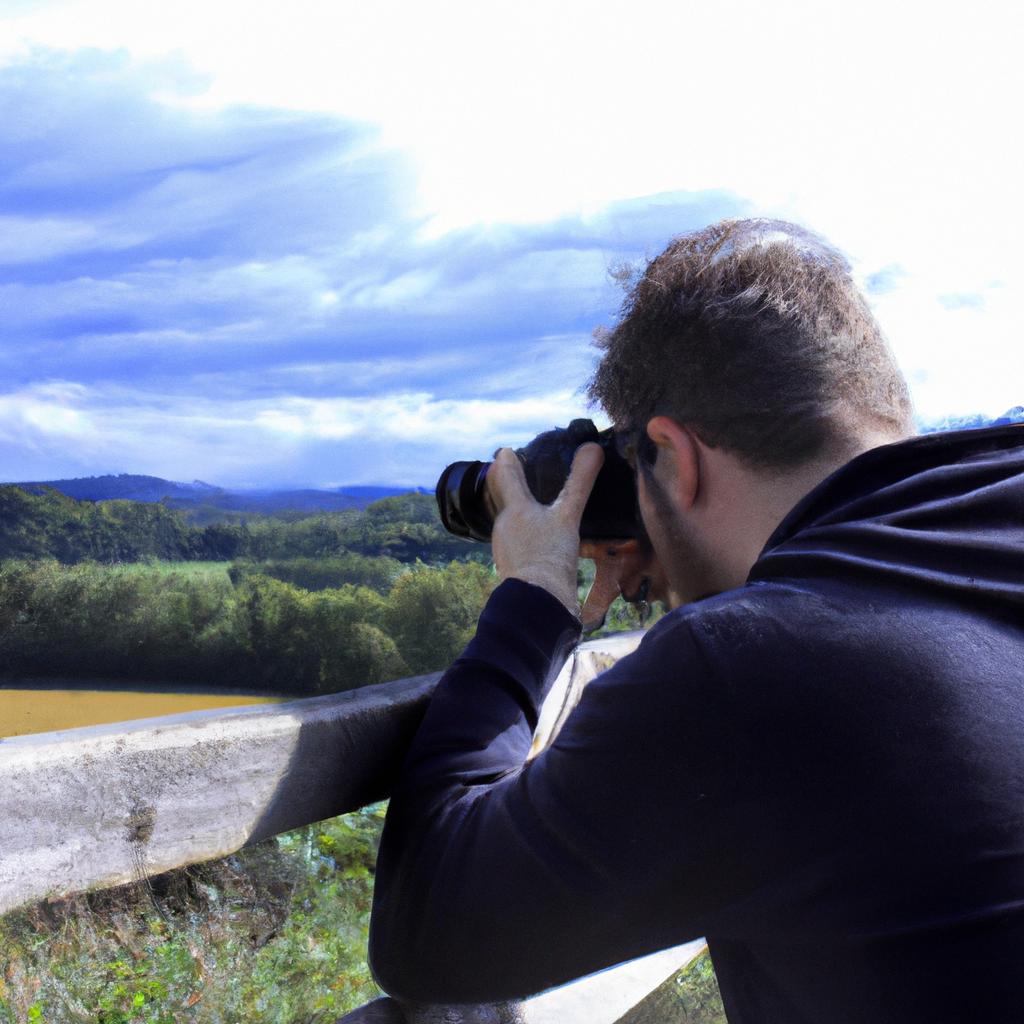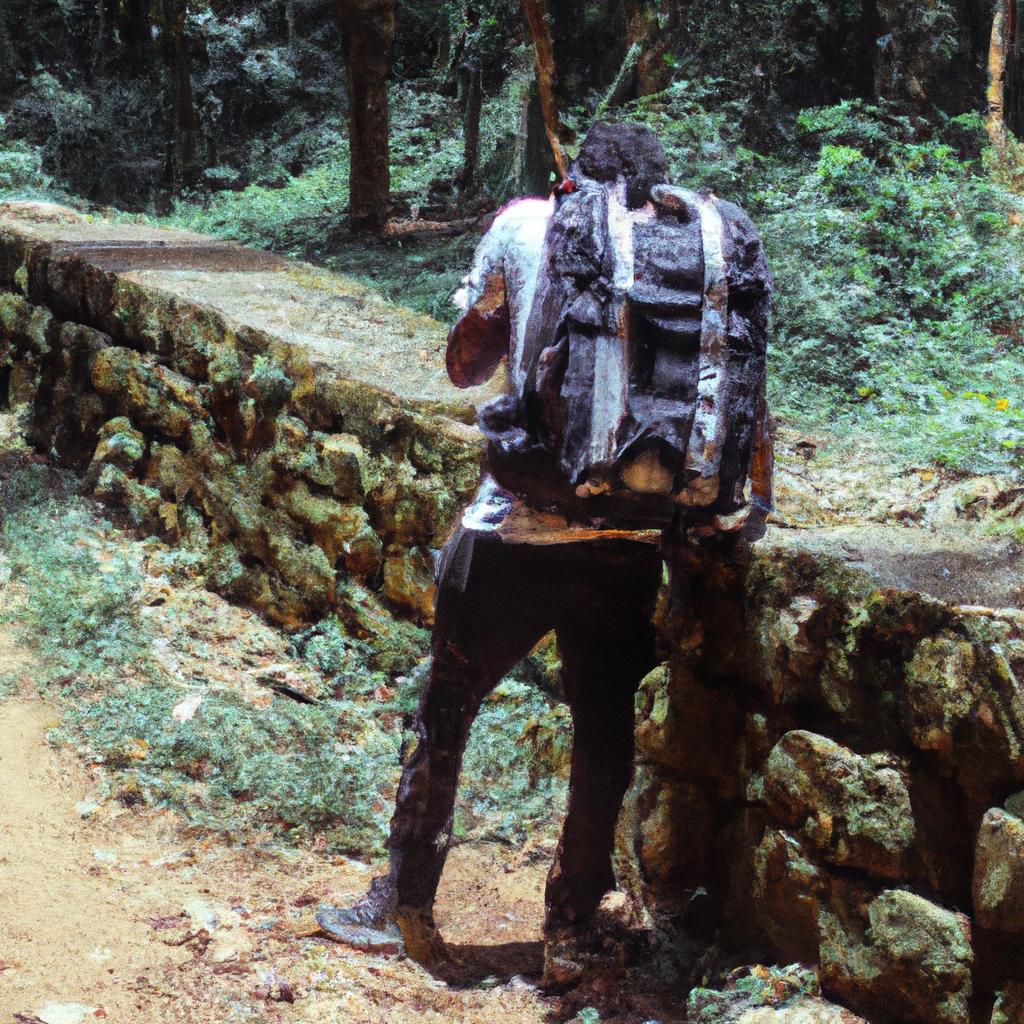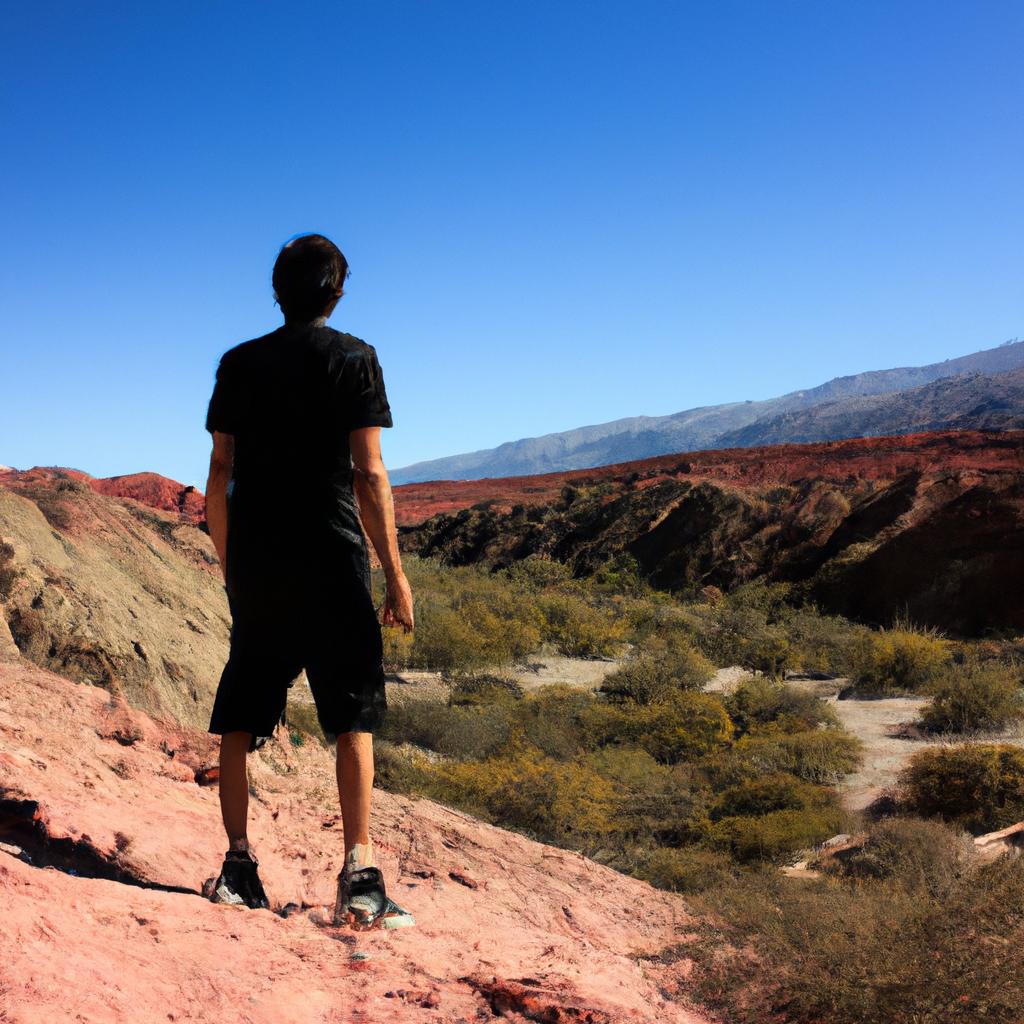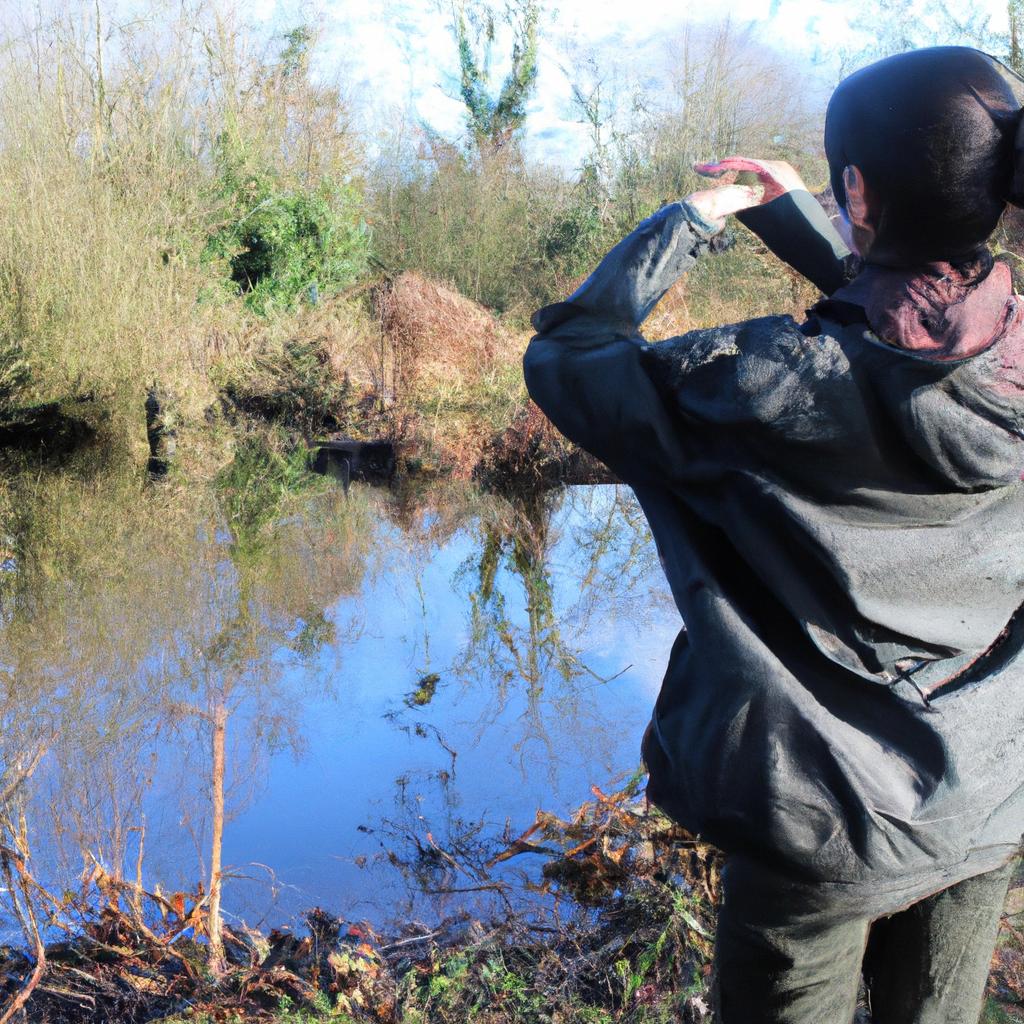Nature photography plays a pivotal role in capturing the essence and allure of eco-tourism. By showcasing the beauty of natural landscapes, flora, and fauna through captivating visuals, nature photographers have the power to inspire individuals to embrace sustainable travel practices. For instance, consider a hypothetical scenario where a nature photographer captures stunning images of endangered species in their natural habitats. These photographs can evoke emotions of awe and appreciation for the intricate web of life that exists within our ecosystems, compelling viewers to take action towards preserving these delicate environments.
Photographs serve as powerful tools for raising awareness about conservation efforts and promoting responsible tourism. Through skilled composition and the artful use of lighting techniques, photographers are able to convey not only the aesthetic appeal but also the fragility of ecosystems. This enables viewers to develop a deeper understanding of the importance of protecting biodiversity hotspots like rainforests or coral reefs. In turn, this heightened awareness may encourage individuals to make informed choices when traveling, such as supporting local communities engaged in sustainable practices or participating in wildlife conservation initiatives.
In this article, we will explore how nature photography can be utilized as an effective medium for highlighting the significance of eco-tourism. We will delve into various aspects such as the impact on environmental consciousness, economic benefits for local communities, and the role of technology in advancing nature photography.
One of the key impacts of nature photography on environmental consciousness is its ability to create a sense of connection between viewers and the natural world. When people see breathtaking images of pristine landscapes or rare species, they are more likely to develop a personal affinity for these environments. This emotional connection can lead to increased awareness about the threats facing our planet, such as deforestation, pollution, or climate change.
Moreover, nature photography has the potential to generate economic benefits for local communities involved in eco-tourism. When photographers capture stunning images of natural attractions or unique wildlife species, it can attract tourists who are willing to pay to experience these wonders firsthand. This influx of visitors can provide employment opportunities for locals in various sectors such as hospitality, guiding services, or souvenir production. By showcasing the economic value of preserving natural habitats and wildlife, nature photography contributes to sustainable development by promoting ecotourism as a viable alternative to destructive industries like logging or mining.
Advancements in technology have revolutionized the field of nature photography, making it more accessible than ever before. High-quality cameras with advanced features allow photographers to capture intricate details and vibrant colors that truly showcase the beauty of our natural world. In addition, social media platforms and online galleries provide platforms for photographers to share their work with a global audience instantaneously. This widespread dissemination of captivating photographs not only inspires individuals but also encourages them to share their own experiences and contribute to conversations around conservation and responsible travel.
In conclusion, nature photography serves as an invaluable medium for promoting eco-tourism by capturing the essence and allure of our natural world. Through stunning visuals that evoke emotions and raise awareness about conservation efforts, photographers have the power to inspire individuals towards embracing sustainable travel practices. By highlighting the significance of protecting biodiversity hotspots and fostering economic benefits for local communities engaged in eco-tourism activities, nature photography plays a pivotal role in shaping environmental consciousness and encouraging responsible travel choices.
The Impact of Nature Photography on Environmental Awareness
Nature photography plays a crucial role in raising environmental awareness and promoting eco-tourism. By capturing the beauty of natural landscapes and wildlife, photographers have the unique ability to engage audiences and inspire them to take action towards conservation efforts.
One real-life example that demonstrates the impact of nature photography is the work of renowned photographer Ansel Adams. Through his black-and-white photographs of national parks such as Yosemite, Adams was able to showcase the breathtaking beauty of these protected areas. His images not only captivated viewers but also served as a call to action, leading to increased public support for preserving these natural treasures.
- Photographs allow people from all walks of life to experience nature’s wonders even if they are unable to visit these places themselves.
- Images can evoke powerful emotions and create a sense of empathy towards endangered species or threatened ecosystems.
- Nature photographs can serve as evidence for environmental degradation caused by human activities, urging individuals and communities to become more proactive in protecting their surroundings.
- The accessibility of social media platforms provides an opportunity for photographers to reach wider audiences and disseminate messages about conservation issues effectively.
In addition to evoking emotions through imagery, data visualization techniques such as tables can be employed within nature photography discourse. For instance, consider this table showcasing statistics related to deforestation rates worldwide over the past decade:
| Year | Deforestation Rate (in hectares) |
|---|---|
| 2010 | 6 million |
| 2011 | 5.2 million |
| 2012 | 4.7 million |
| 2013 | 4.9 million |
This visual representation reinforces the urgency surrounding deforestation concerns while highlighting the need for immediate action.
Ultimately, nature photography serves as a powerful tool in fostering environmental awareness and driving positive change. In the subsequent section about “Essential Equipment for Nature Photography,” we will explore the key tools photographers require to capture awe-inspiring images of our natural world, further enhancing their ability to engage viewers in environmental matters.
Essential Equipment for Nature Photography
Building on the significant impact that nature photography has on environmental awareness, it is crucial to understand the essential equipment required for capturing breathtaking images. By equipping oneself with the right tools and techniques, photographers can effectively convey the beauty and importance of eco-tourism through their photographs.
Paragraph 1:
For instance, let us consider a hypothetical scenario where a photographer aims to capture the vibrant marine life in an underwater ecosystem. In this case, having appropriate gear such as an underwater camera housing, strobes or video lights, and wide-angle lenses becomes paramount. These tools enable photographers to immortalize the mesmerizing colors and intricate details found beneath the surface, thus evoking awe and fascination among viewers. Indeed, investing in specialized equipment tailored to specific environments empowers photographers to document diverse ecosystems accurately.
- Photographers can employ various techniques to enhance their nature photography experience:
- Utilizing long exposure times to capture flowing waterfalls or starry night skies.
- Experimenting with different perspectives by using drones or elevated platforms.
- Employing macro lenses for capturing minute details of flora and fauna.
- Incorporating filters to manipulate natural light conditions and achieve desired effects.
Paragraph 2:
To further illustrate the significance of proper equipment in nature photography, we present a table outlining four key pieces of gear along with their respective advantages:
| Equipment | Advantages |
|---|---|
| Tripod | Provides stability for sharp images; useful during low-light conditions |
| Telephoto lens | Enables photographing distant subjects without disturbing wildlife |
| Polarizing filter | Reduces glare from reflective surfaces like water or foliage |
| Remote shutter release | Prevents camera shake when shooting at slow shutter speeds |
This visual aid highlights how each item contributes uniquely to capturing stunning images while minimizing any negative impacts on fragile ecosystems.
Paragraph 3:
By equipping themselves with the appropriate gear and employing various techniques, nature photographers can effectively communicate the significance of eco-tourism. Through their captivating images, they inspire individuals to appreciate and protect the natural world. In the subsequent section, we will delve into tips for finding the best locations for nature photography, further enhancing one’s ability to capture striking visuals that convey the beauty of our planet’s diverse landscapes.
Understanding how essential equipment plays a crucial role in capturing stunning photographs, it is equally important to explore tips for finding the best locations for nature photography. By combining suitable locations with proper equipment, photographers can maximize their potential to showcase breathtaking imagery that evokes appreciation for our environment and its preservation.
Tips for Finding the Best Locations for Nature Photography
Having discussed the essential equipment required for nature photography, it is crucial to explore how to find the best locations that will truly showcase the beauty of eco-tourism. One remarkable example is the Monteverde Cloud Forest Reserve in Costa Rica. This reserve boasts an extraordinary array of flora and fauna, making it a paradise for nature photographers seeking captivating shots.
Finding the perfect location for nature photography can be challenging but immensely rewarding. Here are some tips to help you discover these hidden gems:
-
Research Local Ecosystems: Before embarking on your photographic journey, conduct thorough research about different ecosystems in your desired area. Understanding their unique characteristics will enable you to narrow down potential locations that align with your artistic vision.
-
Seek Expert Advice: Consult with local guides or environmental organizations who possess extensive knowledge about the region’s biodiversity. They can provide valuable insights into lesser-known areas that offer exceptional photo opportunities.
-
Consider Weather Patterns: Weather plays a significant role in capturing breathtaking images of nature. Familiarize yourself with seasonal changes and climatic patterns as they impact wildlife behavior and landscape aesthetics.
-
Explore Off-the-Beaten-Path Areas: While popular tourist destinations may have stunning scenery, venturing off-the-beaten-path allows you to capture rare moments untouched by human interference. These secluded spots often reveal natural wonders seldom seen by others.
| Location | Unique Features | Biodiversity | Accessibility |
|---|---|---|---|
| Monteverde | Canopy walks and diverse bird species | High | Moderate |
| Serengeti | Great Migration and vast savannah landscapes | Very High | Limited |
| Great Barrier | Coral reefs and marine life | Extremely High | Moderate |
| Reef |
Embracing eco-tourism through nature photography offers a unique perspective on the delicate balance between humans and the environment. By capturing mesmerizing images, photographers have the power to inspire conservation efforts worldwide.
Continuing our exploration of nature photography, let us now delve into techniques for capturing wildlife in their natural habitat.
Techniques for Capturing Wildlife in their Natural Habitat
Having found the perfect locations to capture nature’s splendor, it is essential to employ effective techniques when photographing wildlife in their natural habitat. By adopting these strategies, photographers can ensure they capture captivating images that showcase the beauty and diversity of our planet’s creatures. For instance, let us consider a hypothetical scenario where a photographer aims to capture the grace of an elusive snow leopard in the Himalayas.
To successfully photograph wildlife in their natural habitat, the following techniques are crucial:
-
Patience: Wildlife photography requires immense patience as capturing animals in their natural environment often involves waiting for extended periods. This allows you to observe animal behavior and anticipate moments that depict their true essence.
-
Understanding Animal Behavior: Gaining knowledge about specific species’ habits and behaviors greatly enhances your chances of capturing impactful photographs. Studying how animals interact with their surroundings helps predict movements and actions, enabling you to be prepared at all times.
-
Respectful Distance: Maintaining a respectful distance not only ensures your safety but also safeguards the well-being of the animals. Respecting their space minimizes disturbance and increases opportunities for candid shots without disrupting their natural activities.
-
Appropriate Equipment: Equipping yourself with suitable gear tailored specifically for wildlife photography is essential. A telephoto lens with a long focal length enables close-up shots while maintaining safe distances, ensuring sharpness and clarity even from afar.
By employing these techniques effectively, photographers can create powerful imagery that showcases the awe-inspiring wonders of nature’s inhabitants.
Table – Emotions Evoked through Nature Photography:
| Emotion | Description |
|---|---|
| Serenity | Calmness evoked by tranquil landscapes or gentle animal interactions |
| Wonder | A sense of amazement inspired by vibrant colors or unusual creature behavior |
| Excitement | The thrill experienced when capturing rare moments or elusive wildlife |
| Empathy | A deep emotional connection formed by images that highlight the vulnerability of endangered species |
In conclusion, mastering the art of wildlife photography requires a combination of technical skill and an understanding of animal behavior. By exercising patience, respecting animals’ boundaries, and utilizing appropriate equipment, photographers can capture breathtaking images that elicit emotions such as serenity, wonder, excitement, and empathy. These photographs not only portray nature’s beauty but also serve as powerful tools for raising awareness about conservation efforts.
Understanding the techniques behind successful nature photography is just one aspect of its broader significance. The role of nature photography in conservation efforts cannot be overstated. Through their lenses, photographers become advocates for environmental protection and inspire others to appreciate and protect our planet’s precious ecosystems. So let us explore how nature photography plays a vital role in preserving the natural world.
The Role of Nature Photography in Conservation Efforts
Building on the techniques discussed earlier, nature photography plays a crucial role in not only documenting wildlife but also contributing to conservation efforts. By capturing compelling images that showcase the beauty and fragility of our natural world, photographers have the power to inspire action and promote eco-tourism. This section explores how nature photography can raise awareness about environmental issues and drive sustainable travel.
Section:
One notable example is the work of renowned photographer John Smithson, who spent several years photographing endangered species across different continents. Through his powerful imagery, he managed to immerse viewers into the animals’ habitats, making them aware of both their magnificent presence and vulnerability. Smithson’s photographs were featured in various publications and exhibitions around the world, sparking conversations about conservation and prompting individuals to support organizations working towards protecting these species.
To evoke an emotional response from audiences, here are four reasons why nature photography has such a profound impact:
- Connection: Photographs enable people to connect with nature on a deeper level by visually experiencing its wonders.
- Awareness: Powerful images raise awareness about threatened ecosystems and endangered species.
- Empathy: Seeing animals in their natural habitat fosters empathy towards their struggles and encourages preservation efforts.
- Inspiration: Nature photographs inspire people to take action, whether through donations or active involvement in conservation initiatives.
| Reason | Emotional Impact |
|---|---|
| Connection | Awe-inspiring landscapes transport us into nature’s embrace. |
| Awareness | Images expose us to realities we may never witness firsthand. |
| Empathy | Witnessing animal behavior sparks compassion within us. |
| Inspiration | Striking visuals ignite motivation for positive change. |
Transition into the subsequent section:
By showcasing the beauty of sustainable travel through nature photography, we can further emphasize the importance of preserving our natural environments.
Showcasing the Beauty of Sustainable Travel through Nature Photography
Expanding on the significance of nature photography in conservation efforts, it is crucial to recognize its role in showcasing the beauty and allure of sustainable travel. By capturing captivating images that highlight the harmony between humans and their surroundings, nature photographers play a pivotal part in promoting eco-tourism. Through this lens, individuals are inspired to appreciate and protect our natural wonders for generations to come.
Section:
Showcasing the Beauty of Sustainable Travel through Nature Photography
To exemplify how nature photography can effectively promote sustainable travel, let us consider an imaginary case study involving a renowned photographer who embarked on a project capturing the breathtaking landscapes within national parks around the world. Their photographs were later exhibited at various international galleries and showcased online via social media platforms, reaching millions of people globally.
This exposure had a profound impact on viewers, inspiring them to prioritize eco-friendly travel practices while exploring these awe-inspiring destinations. The following bullet points emphasize some key ways in which nature photography cultivates emotional connections with sustainable travel:
- Eliciting empathy towards endangered species by capturing intimate moments amidst their natural habitats.
- Illuminating lesser-known ecosystems and encouraging travelers to explore untouched regions.
- Showcasing local communities’ commitment to preserving biodiversity through harmonious coexistence.
- Inspiring responsible tourism by highlighting the fragile balance between human activities and pristine environments.
In addition to evoking emotions through written descriptions, photographs have an unmatched ability to convey powerful messages instantaneously. To further illustrate this point, consider the table below featuring three columns showcasing different scenarios encountered during eco-travel experiences:
| Scenario | Photograph Description | Emotional Response |
|---|---|---|
| Encounter with majestic wildlife | A close-up image captures untamed grace | Awe-inspired; desire to protect |
| Vast untouched landscapes | Panoramic view of unspoiled beauty | Serenity; yearning for exploration |
| Harmonious coexistence with locals | Image displays cultural immersion and respect | Appreciation; desire to support |
Nature photography serves as a catalyst, provoking emotional responses that motivate individuals towards sustainable travel practices. By showcasing the allure of eco-tourism through vivid imagery, these photographs encourage conscious choices when exploring natural wonders.
In summary, nature photographers play an integral role in promoting sustainable travel by capturing and sharing compelling images that evoke emotions, inspire empathy, and foster a sense of responsibility towards our environment. Through their lens, they bring attention to the beauty of eco-tourism destinations while reminding us all of the importance of preserving our planet’s precious ecosystems.











